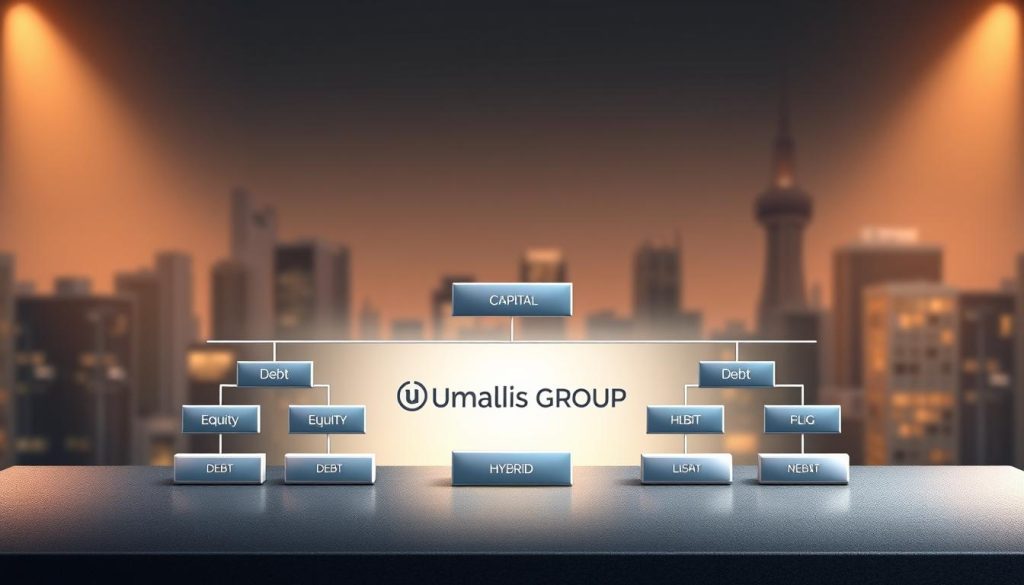Did you know that a large share of freelancers run out of cash within three months after a big missed invoice? This single fact shows why clear systems matter.
We frame finance as the operating system of your solo business. It keeps your money flowing, bills paid on time, and goals within reach.
You will see how the role of a company’s finance team becomes your role as owner-operator. That means invoicing, reconciling bank transactions, tracking payables, and closing the month with simple checklists.
Our aim is practical: protect solvency first, then grow value through pricing and cost control. We offer bite-sized steps and a steady planning cadence so you can allocate funds for taxes, operations, and savings.
Result: fewer surprises, more clarity, and confidence to make capital choices that support steady growth in France and beyond.
Table of Contents
Key Takeaways
- Treat finance as your business operating system to organize cash and obligations.
- Simple processes—invoice terms, bank reconciliation, month-end close—prevent crisis.
- Prioritize solvency, then profitability, then controlled growth.
- Allocate funds for taxes, operating costs, and savings before discretionary spend.
- Use basic capital budgeting and reporting to decide when to invest in tools or training.
Ultimate Guide Foundations: What financial management means for solo businesses
Running your own practice means turning corporate finance tasks into simple weekly and monthly habits. In a company, teams handle invoicing, payables, reconciliation, forecasting, and reporting. As a solo professional, you become the financial manager who adapts those same functions to a lean routine.
From company finance to freelance practice: translating roles and functions
Receivables, payables, and reconciliation become checklists you run weekly. Track due invoices, validate expenses, and reconcile bank transactions to keep control of cash.
Close the month with a short review: unpaid bills, incoming receipts, and any adjustments. This small habit gives you clarity without heavy overhead.
Core objectives for freelancers: solvency, profitability, and controlled growth
Your first goal is solvency—make sure bills are covered and assets are safe. Next, aim for profitability by setting disciplined prices and trimming avoidable costs.
Finally, plan growth deliberately. Use simple capital budgeting for tools or training and follow a weekly cash review plus a monthly close. For a step-by-step planning approach, see our guide to financial planning for freelancers.
- Weekly: cash check and invoice follow-ups.
- Monthly: reconcile accounts and record decisions.
- Quarterly: review pricing, buffer levels, and capital choices.
Set up your freelance finance system the right way
A clear system for invoices, payables, and reconciliation turns chaos into control. Start with small rules that run every week and month. This brings predictability to cash and reduces surprises.

Invoicing and receivables
Standardize invoice terms (Net 7/14), add late-fee rules, and use milestone schedules. Consider MRR-style retainers to convert sporadic projects into steady money.
- Receivables tracker flags 7, 14, 30-day overdue items.
- Use templated follow-ups and an escalation path before collections.
Payables and expenses
Categorize subscriptions, software, travel, contractor fees, and equipment so your ledger shows true margins.
Batch vendor bills weekly. Take early-payment discounts when they make sense and avoid late fees that shrink profit.
Banking and reconciliation
Keep one business account, one tax savings account, and one operations buffer. Transfer rules keep structure and discipline.
- Do a monthly bank reconciliation matching every transaction.
- Close the month: reconcile, check P&L, update cash forecast, export a one-page report.
Tip: Choose simple tools or financial management software that fit your time and skills. For processes and templates tailored to freelancers, see our guide on freelance management.
Financial planning and budgeting for stability and growth
Scenario-based planning helps you decide when to hire, cut, or wait. Start by budgeting per project and client. Assign direct and indirect costs and log time so pricing covers delivery and overhead with a healthy margin.
Planning income and costs by project, client, and time
Break estimates into time, materials, and shared overhead. Reconcile each budget line to your ledger so every cost maps to real bank movements.
Scenario modeling and forecasting: best case, base case, worst case
Build a rolling 12-month plan with three cases. Use assumptions (next quarter revenue range, utilization, and pipeline) to set hiring or subcontracting triggers.
Cash management: buffers, emergency funds, and timing mismatch
Rule of thumb: keep a cash buffer equal to 3–6 months of operating expenses and an emergency fund for timing gaps between receivables and payables.
- Monthly forecasts update assumptions quickly to reflect pipeline or rate changes.
- Track billable utilization, average rate, and project variance to protect profitability.
- Create a simple risk register for client concentration, late payments, and scope change, with clear mitigations.
We recommend a steady cadence: weekly pipeline review, monthly forecast update, and quarterly plan refresh. For a step-by-step approach to independence and long-term goals, see our guide on financial independence.
Capital structure and investment decisions for freelancers
How you structure the money behind an investment determines whether it helps or strains your cash flow. In a solo business, capital typically mixes your retained equity and selective debt. That mix affects flexibility, risk, and long-term value.

Use debt when you have predictable cash (retainers or steady clients) and a clear payback path. Prefer equity—your saved capital—when you need flexibility and want to avoid fixed repayments.
Capital budgeting: tools, training, and innovation that add value
Apply simple methods: payback period and expected ROI. Size the amount capital by linking projected revenue uplift or cost savings to a conservative margin of safety.
- Distinguish working capital (bridge gaps) from long-term investment (growth bets).
- Pilot tools or courses before full rollout to preserve value.
- Compare buy vs. lease by converting to total cost of ownership and expected utilization.
Checklist for responsible debt: fixed rates preferred, no stiff prepayment penalties, covenants you can meet, and debt service well within baseline cash flow.
Document decisions with assumptions, scenarios, and exit criteria. This simple discipline lets you adopt the role of a pragmatic financial manager and keep profitability and resilience aligned. For independence-focused planning, see our guide to financial autonomy.
Why financial management is important to your freelance business
Clear routines around pricing, billing, and expenses protect your cash and your peace of mind. They make solvency predictable and give you simple signals when to act.
Profitability, pricing, and cost control to protect margins
Set prices by linking costs, target margin, and market position. Then check project profit monthly to confirm you hit your target.
Trim expenses that add little value. Negotiate vendor rates, pause unused subscriptions, and batch purchases to keep service quality while lowering costs.
Risk and compliance: taxes, regulations, and financial control
Adopt simple control routines: documented invoices, timely expense records, and matched receipts. These steps reduce the chance of fines and errors.
Plan taxes proactively by setting aside a fixed percent of receipts as they arrive. This avoids unexpected bills and keeps cash stable.
- Key actions: deposits or milestone billing to limit late-pay risk.
- Signals: rising receivable aging or falling utilization require immediate analysis.
- Outcome: fewer surprises and stronger client negotiation backed by numbers.
One-page report for faster decisions
Build a concise monthly report: revenue, gross margin, operating expenses, cash runway, and pipeline. Use it to guide pricing and staffing choices.
| Metric | Target | Action if off-track | Frequency |
|---|---|---|---|
| Gross margin | ≥ 60% | Raise rates or cut low-value costs | Monthly |
| Receivables aging | Invoice follow-up and deposit terms | Weekly | |
| Cash runway | 3–6 months | Pause investments; increase retainer focus | Monthly |
Tools of the trade: financial management software and workflows
A smart stack replaces manual entries with reliable, repeatable flows that save hours each month. Start by comparing spreadsheets to dedicated apps and pick what removes friction for you.
From spreadsheets to modern apps: invoicing, expenses, and reporting
Spreadsheets work at first. They teach structure and keep costs low. But errors grow and reconciliation eats time as your company scales.
Graduate to invoicing apps, receipt capture, and bank feeds when automation reduces mistakes and frees up billing time. Connect these sources so data flows into one ledger. That lowers review time for your financial manager or external bookkeeper.
Dashboards, KPIs, and variance analysis for smarter decisions
Build a lean dashboard with MRR/project mix, utilization, average rate, gross margin, receivables aging, and cash runway. Use monthly variance analysis to turn deviations into actions: repricing, renegotiation, or scope guardrails.
- Keep a closing checklist in your stack: reconcile, review, export.
- Standardize chart of accounts, naming, and tags by client or project.
- Enable forecasting views that combine pipeline probabilities and retainer commitments.
Collaboration: define roles for document collection, categorization, and sign-off when you work with a bookkeeper or CPA. Small daily maintenance in your tools keeps month-end light and your numbers decision-ready.
Conclusion
Small, regular rituals for cash and costs create the backbone of a resilient independent practice.
You now have practical ways to plan and allocate funds, manage expenses with intent, and protect profit through disciplined pricing and cost control.
Treat finance as part of your craft: short weekly checks and a simple month-end close keep your numbers accurate and useful. This makes capital decisions — equipment, innovation, or small investments — safer and clearer.
Keep reserves first, set taxes aside, then reinvest. Maintain a multi-month cash buffer and track materials and assets so every purchase earns its place.
Show organized numbers to clients and partners. That builds trust and prepares you to work with larger teams or a formal department when the time comes.
For steps on building runway and independence, see our guide to financial freedom through freelancing. Adopt these habits and your solo job becomes a resilient company that meets goals with confident decisions.
FAQ
What does good financial management mean for a solo professional?
It means organizing income, expenses, and capital so you remain solvent and profitable. Start with clear invoicing, separate business accounts, and simple budgeting by client or project. This creates predictable cash flow and supports sustainable decisions.
How do I translate company finance roles into my freelance practice?
You adopt the core functions: planning, control, reporting, and risk management. One person may handle strategy, bookkeeping, billing, and tax filings. Use simple tools—accounting software, a calendar for payments, and periodic reviews—to cover each role reliably.
What are the core objectives I should track as an independent professional?
Focus on solvency (being able to pay bills), profitability (protecting margins through pricing and cost control), and controlled growth (scaling only when you have cash and capacity). Regularly measure receivables, net income, and utilization.
How should I set up invoicing and receivables to reduce late payments?
Define clear payment terms, issue invoices promptly, and offer online payment options. Consider using retainer or MRR-style contracts for recurring income and automated reminders for collections. A short, consistent follow-up routine reduces days sales outstanding.
What is the best approach to managing payables and subscriptions?
Track vendor bills and recurring charges in one system and schedule payments to optimize cash flow. Regularly review subscriptions and equipment costs to cut unnecessary spend. Prioritize payments that protect operations and credit.
How important is bank reconciliation and monthly closing?
Very. Reconciling accounts monthly keeps ledgers clean, uncovers errors, and produces reliable reports. A tidy close process makes tax time easier and gives accurate data for decisions.
How do I plan income and costs by project or client?
Estimate revenues and direct costs per engagement, then allocate indirect costs (tools, subscriptions, overhead) across projects. Use simple templates to compare projected margins and set minimum acceptable fees before accepting work.
What is scenario modeling and how often should I do it?
Scenario modeling builds best-case, base-case, and worst-case forecasts to test cash flow under different assumptions. Update quarterly or when you expect major changes (new client, big expense) to stay prepared.
How much cash reserve should an independent worker keep?
Aim for a buffer covering 3–6 months of essential expenses. Keep this in an accessible account to handle timing mismatches between invoices and bills, and to reduce reliance on high-cost credit.
When does taking on debt make sense for a solo business?
Consider loans when financing growth that will clearly increase revenue or when investing in tools that boost productivity and margins. Avoid debt for routine cash shortfalls; prefer reserves and tighter expense control instead.
What is capital budgeting for a freelancer?
It’s the process of evaluating investments—software, training, equipment—by estimating costs, benefits, and payback time. Prioritize items with measurable returns and short payback periods to protect cash.
How do I set prices to protect my margins?
Base fees on value and total cost of service, not only time. Factor in taxes, benefits you no longer receive as an employee, overhead, and a profit margin. Regularly review rates and use clear contracts to avoid scope creep.
What steps reduce risk and ensure compliance?
Keep accurate records, separate personal and business funds, set aside tax payments, and consult an accountant for filings. Maintain insurance where appropriate and stay informed on regulations affecting your activity.
Which tools are most useful for solo professionals?
Start with a reliable accounting app like QuickBooks Self-Employed or FreshBooks, a payments solution such as Stripe, and a secure bank account dedicated to business. Supplement with spreadsheet templates and a simple dashboard for KPIs.
What KPIs should I track weekly or monthly?
Monitor cash on hand, receivables aging, net income, utilization or billable hours, and gross margin by project. These indicators show liquidity, profitability, and operational efficiency.
How do dashboards and variance analysis help my decisions?
Dashboards consolidate key metrics so you spot trends quickly. Variance analysis compares actuals to budgets to reveal where you under- or over-perform, enabling corrective actions that protect profit and cash.





